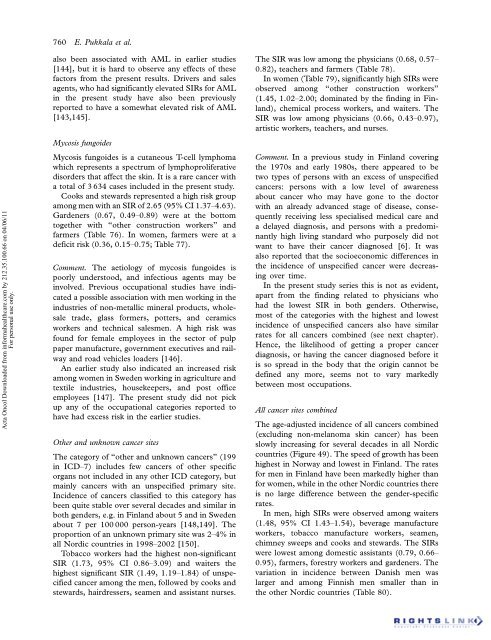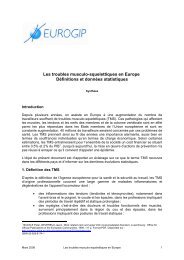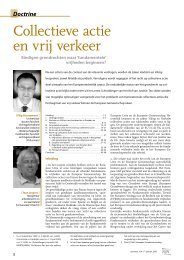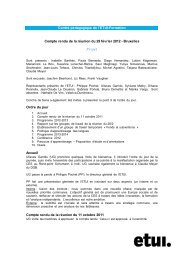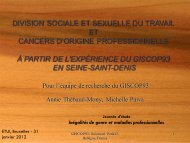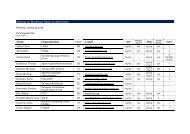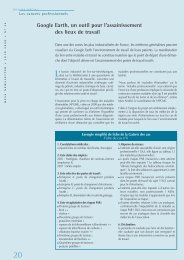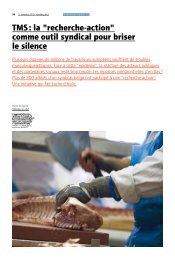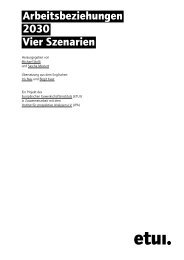Occupation and cancer - European Trade Union Institute (ETUI)
Occupation and cancer - European Trade Union Institute (ETUI)
Occupation and cancer - European Trade Union Institute (ETUI)
You also want an ePaper? Increase the reach of your titles
YUMPU automatically turns print PDFs into web optimized ePapers that Google loves.
Acta Oncol Downloaded from informahealthcare.com by 212.35.100.66 on 04/06/11<br />
For personal use only.<br />
760 E. Pukkala et al.<br />
also been associated with AML in earlier studies<br />
[144], but it is hard to observe any effects of these<br />
factors from the present results. Drivers <strong>and</strong> sales<br />
agents, who had significantly elevated SIRs for AML<br />
in the present study have also been previously<br />
reported to have a somewhat elevated risk of AML<br />
[143,145].<br />
Mycosis fungoides<br />
Mycosis fungoides is a cutaneous T-cell lymphoma<br />
which represents a spectrum of lymphoproliferative<br />
disorders that affect the skin. It is a rare <strong>cancer</strong> with<br />
a total of 3 634 cases included in the present study.<br />
Cooks <strong>and</strong> stewards represented a high risk group<br />
among men with an SIR of 2.65 (95% CI 1.37 4.63).<br />
Gardeners (0.67, 0.49 0.89) were at the bottom<br />
together with ‘‘other construction workers’’ <strong>and</strong><br />
farmers (Table 76). In women, farmers were at a<br />
deficit risk (0.36, 0.15 0.75; Table 77).<br />
Comment. The aetiology of mycosis fungoides is<br />
poorly understood, <strong>and</strong> infectious agents may be<br />
involved. Previous occupational studies have indicated<br />
a possible association with men working in the<br />
industries of non-metallic mineral products, wholesale<br />
trade, glass formers, potters, <strong>and</strong> ceramics<br />
workers <strong>and</strong> technical salesmen. A high risk was<br />
found for female employees in the sector of pulp<br />
paper manufacture, government executives <strong>and</strong> railway<br />
<strong>and</strong> road vehicles loaders [146].<br />
An earlier study also indicated an increased risk<br />
among women in Sweden working in agriculture <strong>and</strong><br />
textile industries, housekeepers, <strong>and</strong> post office<br />
employees [147]. The present study did not pick<br />
up any of the occupational categories reported to<br />
have had excess risk in the earlier studies.<br />
Other <strong>and</strong> unknown <strong>cancer</strong> sites<br />
The category of ‘‘other <strong>and</strong> unknown <strong>cancer</strong>s’’ (199<br />
in ICD 7) includes few <strong>cancer</strong>s of other specific<br />
organs not included in any other ICD category, but<br />
mainly <strong>cancer</strong>s with an unspecified primary site.<br />
Incidence of <strong>cancer</strong>s classified to this category has<br />
been quite stable over several decades <strong>and</strong> similar in<br />
both genders, e.g. in Finl<strong>and</strong> about 5 <strong>and</strong> in Sweden<br />
about 7 per 100 000 person-years [148,149]. The<br />
proportion of an unknown primary site was 2 4% in<br />
all Nordic countries in 1998 2002 [150].<br />
Tobacco workers had the highest non-significant<br />
SIR (1.73, 95% CI 0.86 3.09) <strong>and</strong> waiters the<br />
highest significant SIR (1.49, 1.19 1.84) of unspecified<br />
<strong>cancer</strong> among the men, followed by cooks <strong>and</strong><br />
stewards, hairdressers, seamen <strong>and</strong> assistant nurses.<br />
The SIR was low among the physicians (0.68, 0.57<br />
0.82), teachers <strong>and</strong> farmers (Table 78).<br />
In women (Table 79), significantly high SIRs were<br />
observed among ‘‘other construction workers’’<br />
(1.45, 1.02 2.00; dominated by the finding in Finl<strong>and</strong>),<br />
chemical process workers, <strong>and</strong> waiters. The<br />
SIR was low among physicians (0.66, 0.43 0.97),<br />
artistic workers, teachers, <strong>and</strong> nurses.<br />
Comment. In a previous study in Finl<strong>and</strong> covering<br />
the 1970s <strong>and</strong> early 1980s, there appeared to be<br />
two types of persons with an excess of unspecified<br />
<strong>cancer</strong>s: persons with a low level of awareness<br />
about <strong>cancer</strong> who may have gone to the doctor<br />
with an already advanced stage of disease, consequently<br />
receiving less specialised medical care <strong>and</strong><br />
a delayed diagnosis, <strong>and</strong> persons with a predominantly<br />
high living st<strong>and</strong>ard who purposely did not<br />
want to have their <strong>cancer</strong> diagnosed [6]. It was<br />
also reported that the socioeconomic differences in<br />
the incidence of unspecified <strong>cancer</strong> were decreasing<br />
over time.<br />
In the present study series this is not as evident,<br />
apart from the finding related to physicians who<br />
had the lowest SIR in both genders. Otherwise,<br />
most of the categories with the highest <strong>and</strong> lowest<br />
incidence of unspecified <strong>cancer</strong>s also have similar<br />
rates for all <strong>cancer</strong>s combined (see next chapter).<br />
Hence, the likelihood of getting a proper <strong>cancer</strong><br />
diagnosis, or having the <strong>cancer</strong> diagnosed before it<br />
is so spread in the body that the origin cannot be<br />
defined any more, seems not to vary markedly<br />
between most occupations.<br />
All <strong>cancer</strong> sites combined<br />
The age-adjusted incidence of all <strong>cancer</strong>s combined<br />
(excluding non-melanoma skin <strong>cancer</strong>) has been<br />
slowly increasing for several decades in all Nordic<br />
countries (Figure 49). The speed of growth has been<br />
highest in Norway <strong>and</strong> lowest in Finl<strong>and</strong>. The rates<br />
for men in Finl<strong>and</strong> have been markedly higher than<br />
for women, while in the other Nordic countries there<br />
is no large difference between the gender-specific<br />
rates.<br />
In men, high SIRs were observed among waiters<br />
(1.48, 95% CI 1.43 1.54), beverage manufacture<br />
workers, tobacco manufacture workers, seamen,<br />
chimney sweeps <strong>and</strong> cooks <strong>and</strong> stewards. The SIRs<br />
were lowest among domestic assistants (0.79, 0.66<br />
0.95), farmers, forestry workers <strong>and</strong> gardeners. The<br />
variation in incidence between Danish men was<br />
larger <strong>and</strong> among Finnish men smaller than in<br />
the other Nordic countries (Table 80).


